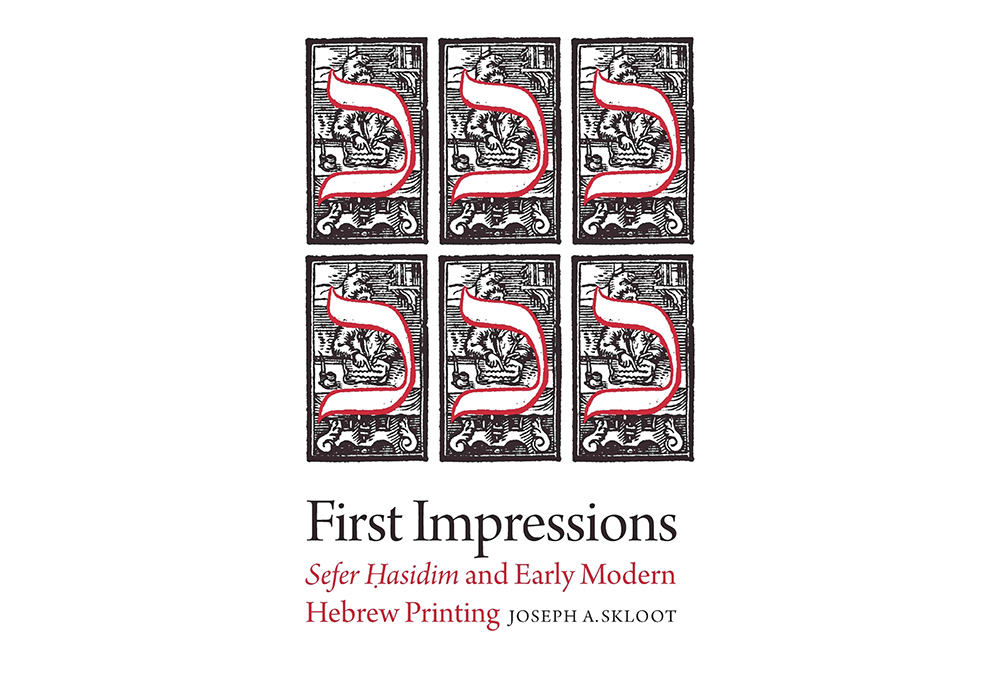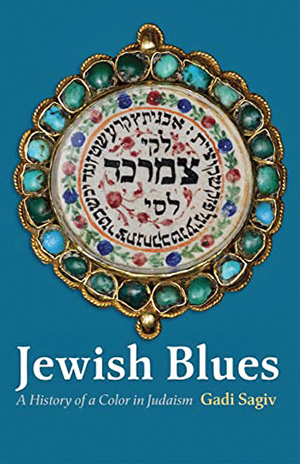Reviewing: “First Impressions: Sefer Ḥassidim and Early Modern Hebrew Printing,” by Joseph A. Skloot. Brandeis University Press, 2023.

Through this fascinating work, the author embarks on a scholarly journey into the first two printings of the renowned pietistic work, Sefer Chassidim. That seminal work is known for its moralistic lessons, presented in the form of stories akin to aggadah, as well as pietistic customs (minhagim) and rulings reminiscent of Halachic decisions. Skloot’s captivating yet meticulously-researched work explores the first two printings of Sefer Chassidim and offers readers a unique perspective on the authorship, paratexts, and the historical context surrounding these editions.
Skloot first focuses on the initial edition of Sefer Chassidim, published in 1538 by “the Partners”—a consortium of Jewish merchants in Bologna, Italy and then turns his attention to the second edition, printed in 1580 by Ambrosius Froben, a well-known Christian printer with Italian roots based in Basel, Switzerland.
The study also takes into account significant historical events that transpired between the two printings, and shows how they influenced aspects of the printing world. Most prominent among these developments are the 1553 banning of the Talmud in Italy and subsequent efforts by the Catholic Church to actively censor Jewish works as part of the Counter-Reformation. Moreover, the emergence of the Great Ashkenazic Yeshivos in Eastern Europe and the organization and establishment of the Vaad of the Four Lands, further contributed to the backdrop that helped the author show the differences between the two historical milieu in which the two printings happened.
In discussing these two early prints of Sefer Chassidim, the author touches on the quasi-philosophical question of what authorship means, examining the motives behind ascribing Sefer Chassidim to Rabbi Yehuda HaChassid of Regensburg, the 12th century leader of the Chassidei Ashkenaz movement.
Each chapter concludes with a succinct summary of its main points, aiding the reader in navigating the book’s rich content. With hundreds of well-sourced endnotes and a robust bibliography, the author provides ample resources for further exploration. The inclusion of a well-structured index enhances the book’s accessibility, allowing readers to easily locate specific topics discussed within its pages.
By employing the scholarly paradigm of microhistory, the author masterfully uses the stories behind the two printings of Sefer Chassidim to shed light on broader questions surrounding the early days of the printing press. This approach illuminates the profound impact of the growing use of this technology on geo-political and geo-religious dynamics. By zooming in on these particular editions, the author provides valuable insights into the interplay between Jewish literature, the printing press, and the complex socio cultural landscape of the time.
 Reviewing: “Jewish Blues: A History of a Color in Judaism,” by Gadi Sagiv, University of Pennsylvania Press, 2022.
Reviewing: “Jewish Blues: A History of a Color in Judaism,” by Gadi Sagiv, University of Pennsylvania Press, 2022.
In this interesting book, the author presents a scholarly exploration of the color blue within the context of Jewish heritage. Focusing on the concept of techeiles, a blue-dyed wool mentioned in various biblical contexts (such as the Tabernacle, the High Priest’s garments, and the commandment of tzitzis), the book delves into the multifaceted nature of this enigmatic hue.
One of the book’s strengths lies in its comprehensive historical overview, which draws upon a wide range of archeological and scientific sources. Through meticulous research, the author traces the evolution of techeiles throughout Jewish history, shedding light on its significance as a distinctly “Jewish” color.
Linguistic analysis forms another compelling aspect of the book, exploring the various terms associated with “blue” in Jewish texts. By unraveling the nuances of terms like kachol and puch, the author uncovers the rich palette of bluish and blue-adjacent colors referenced in Hebrew literature. Notably, the book illuminates the historical significance of Jews in Muslim countries adopting dark clothing, with blue becoming a popular choice due to its cultural importance.
A particularly captivating chapter delves into the esoteric realm, decoding the semiotic meaning of the color blue in Jewish thought. Here, the author explores mystical associations, depicting how blue is said to mirror God’s Throne of Glory and the profound symbolism of blue fire.
Furthermore, the book explores the protective qualities attributed to blue gemstones and the color itself, including its reputed defense against the malevolent forces of the Evil Eye. Looking at the color from a Kabbalistic perspective, the author reveals the profound connections between the color blue, the sefirot, and the unity of God.
Sagiv’s book skillfully tackles the intricate debate surrounding the derivation of blue dyes, particularly techeiles, from various sources. While the color blue can be obtained from several venues, the author highlights the significance of techeiles being derived from a specific marine animal known as a chilazon. Throughout the ages, the question of which mollusk dye precisely constitutes techeiles has sparked intense discussion, with classical rabbinic positions maintaining that the identity of the crustacean has been lost and will only be unveiled in the future.
Notably, this question strikes at the core of contemporary debates that grapple with reconciling normative Halacha with scientific findings. The book examines the differing viewpoints, such as the Radziner Rebbe’s preference for the common cuttlefish (sepia officinalis) and Rav Herzog’s scholarly endorsement of the murex trunculus, offering readers many insights into the ongoing discourse within the wider Orthodox world. In doing so, the author posits an intriguing connection between the quest for restoring ancient techeiles and Messianic motives. In these chapters, the book highlights the profound religious and spiritual implications associated with the color blue within Jewish tradition by exploring the fervor surrounding the potential revival of this historical practice.
In a nutshell, this book is a meticulously-researched and captivating exploration of the color blue’s profound role in Judaism. From its prosaic historical usage to its mystical and esoteric associations, the book provides the reader with a comprehensive understanding of techeiles and its wider implications. As an engaging and thought-provoking edifice, this scholarly study sheds light on the intricate interplay between tradition, faith, and the symbolic power of the color blue.
 Reviewing: “90 Seconds: The Epic Story of Eli Beer and United Hatzalah,” by Rabbi Nachman Seltzer, Shaar Press, 2023.
Reviewing: “90 Seconds: The Epic Story of Eli Beer and United Hatzalah,” by Rabbi Nachman Seltzer, Shaar Press, 2023.
The book started off by vividly depicting Eli Beer as a child traumatized from seeing a bus bombing and not knowing how to help. The trauma of the bus bombing that Eli witnessed at the age of 5, compounded by the repeated tragedy of people who could have been saved dying before the ambulance got there that he saw time and again as a young MADA volunteer, filled him with a burning passion: Something must be done to save more people, to save people better, and to save people faster.
And Eli did it. At its inception, Hatzolah was an underground organization. They used a radio that Eli bought at Radio Shack and smuggled into Israel to hack into MADA’s internal broadcasts. The minute they knew where there was an emergency, the nearest teenaged-volunteer would run over and start doing CPR, keeping the guy alive until the MADA ambulance got there. It was a bare bones operation, but it worked.
One day, a teenaged Eli Beer was manning the radio when he heard there had been a car accident. He raced out to the street and saw a man lying there, bleeding profusely from a torn artery in his neck. Eli whipped his kippah off his head, shoved it into the hole in the guy’s neck, and saved his life.
That was a good story. I would’ve loved more stories like that.
Teenage Eli, saving people with his band of undercover superheroes, grows up to be Eli Beer, the head of Ichud Hatzlolah. Hatzolah has come a long way from its humble origins. It is now a household name, and a major, organized force in saving lives. Today, Hatzolah volunteers have defibrillators. And ambucycles. All of this takes money. Lots of it.
At some point, the book shifts into showing how Eli becomes an incredible fundraiser. I would have been interested in reading more heartwarming stories about the work that Hatzolah volunteers do day in and day out, and less about Eli Beer’s flights all over the world, getting million-dollar donations. This is truly a praiseworthy and wonderful thing, but as a reader it got kind of boring. Ultimately, I read the book and I even enjoyed it. But I was really hoping for more.
By Reuven Chaim Klein and Shira Yael Klein









